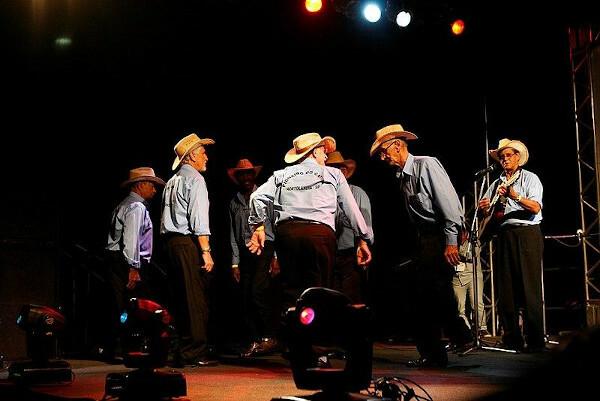A catira is a folk dance Brazilian folklore that happens collectively. Also called Cateretê, it is a typical expression of the region. Southeast, but which gradually spread to other regions, with emphasis on the Midwest. However, it is possible to see the dance in almost all regions of Brazil.
The cultural manifestation is more common in small towns, inland, being recognized as a country culture. The catira groups are formed mostly by men, who are called catireiros. However, there are some groups with female backgrounds.
Read too: Carimbó — a typical circle dance from the northeast of the state of Pará
Topics of this article
- 1 - Origin of catira
- 2 - Catira movements
- 3 - Costume of the catira
origin of catira
With multiple traits, both from Africans, indigenous peoples and Europeans, the catira was a dance considered as a cultural manifestation since the colonial period.
For some historians, it is associated with the activities of the tropeiros, which explains its most striking feature, which mostly brings together only men. The dance would have emerged with those who transported cattle between locations. Therefore, the cat
would have arisen from the group's moments of rest and relaxation.Do not stop now... There's more after the publicity ;)
Some historians argue that the practice of dancing was already performed among the Indians, at the time of Brazil Colony. Portuguese influences can also be considered in relation to dance, due to the presence of the viola, which was created in Portugal and brought to the Brazil by the Jesuits.
Father José de Anchieta he would have been the main promoter of the style here, when he included the rhythm in the celebration rites of the feasts of São Gonçalo, Nossa Senhora da Conceição and São João.
movements of the catira
the catira has as its main feature the foot and hand tapping synchronizedas music rhythm, which, in turn, is produced by the viola caipira. For this reason, viola moda is the most used rhythm. The catira is usually formed by a group of a maximum of ten participants and two guitar players, but this can vary depending on the place where it takes place.

When starting the dance, two rowsto the are made up of members, which move in front of each other. Foot and hand tapping are interspersed with jumping.
The violists can face each other or face the other dancers. They are responsible for initiating the music. This moment is known as ripped.
Next, movements called brush, in which there is a rapid tapping of hands and feet accompanied by six hops.
Throughout the song, there are two other movements, entitled “mountain hill” It is “down hill”. In the first, the dancers rotate one after the other and from left to right, alternating the tapping of their feet and hands. In the second, and after performing the complete turn, they turn and go back with the alternating beats of the feet and hands.
In the movement called jagged, the rows and dancers change places. Lastly, there is the raise, where everyone sings the melody in chorus.
See too: Samba de roda — a Brazilian cultural manifestation that mixes poetry, music and dance
costume design catira
To dance catira it is necessary to wear a specific dance outfit formed by shirt, hat, boots and pants. The boot makes a lot of difference in the costume, as the sound of its beat mixes with the melodies, giving a very impactful effect. The use of tissue It is also common, which may be around the neck or even around the waist.
image credit
[1] Wikimedia Commons (reproduction)
By Erica Caetano
Journalist
Would you like to reference this text in a school or academic work? Look:
CAETANO, Erica. "Catira"; Brazil School. Available in: https://brasilescola.uol.com.br/cultura/catira.htm. Accessed on July 22, 2023.
Present Cacuriá, a folkloric dance from Maranhão.
Click here and learn about the origin of the congada. Learn about the plot, characters, instruments and costumes of this cultural expression.
Click here and find out what frevo is and where it comes from. Know its main characteristics and types.
Cringe
The slang adapted from English is used to designate someone who is seen as tacky, shameful, outdated and out of fashion.


